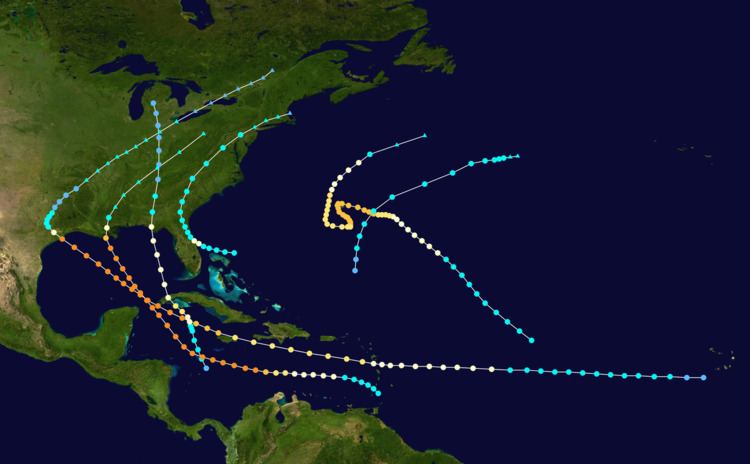First system formed April 29, 1915 Name "New Orleans" Total storms 6 | Last system dissipated October 22, 1915 Total depressions 10 Hurricanes 5 | |
 | ||
The 1915 Atlantic hurricane season ran through the summer and the first half of fall in 1915.
Contents
Systems
The 1915 season was not very active in terms of the number of storms but it was fairly eventful, with two powerful hurricanes hitting the Gulf Coast of the United States.
Hurricane One
The first storm hit Cape Canaveral in early August, turned northeast, and dissipated over New England. The system dropped heavy rainfall across portions of Florida, with a maximum of 16.61 inches (422 mm) recorded at St. Petersburg.
Hurricane Two
The second storm of the year was first observed in the eastern Tropical Atlantic on August 5. It tracked westward, intensifying into a hurricane on the 9th before crossing the Lesser Antilles on the 10th. As the hurricane continued through the Caribbean Sea, it passed just south of Puerto Rico and Hispaniola before crossing Jamaica on August 13 where it caused heavy damage. While south of Cuba it rapidly intensified, and it brushed the western tip of the country on August 15 as a strong Category 4 hurricane. Over the Gulf of Mexico the hurricane weakened slightly. It made landfall near Galveston, Texas as a low-end Category 4 hurricane on August 17. It turned northward, became extratropical on August 18, and dissipated on August 23. Just fifteen years after the 1900 Galveston Hurricane, this hurricane damaged the already hurting Texas economy. Throughout its path, it caused a total of $50 million in damage (1915 USD, $921 million in 2005 USD) and 400 casualties.
Hurricane Three
Hurricane Three, which was first observed on August 28 in the central Tropical Atlantic, tracked northwestward to reach a peak of 120 mph winds. It stalled and drifted south near Bermuda, bringing heavy surf and moderate damage to the island. The hurricane turned to the west, north, and finally recurved out to sea, becoming extratropical on September 10.
Hurricane Four
On August 31, a tropical storm developed southwest of Jamaica. It headed north-northwestward, strengthening to a Category 2 hurricane as it made landfall on western Cuba. It weakened to 90 mph (130 km/h) winds when it hit near Apalachicola, Florida on September 4. The storm continued northward and dissipated on September 9 over southern Michigan. Well-executed warnings kept the death toll to 0, and the hurricane only caused minor to moderate damage with high tides occurring.
Tropical Storm Five
This strong tropical storm remained over the open ocean.
Hurricane Six
The sixth and final storm of the year was first seen just west of the Lesser Antilles on September 22. It tracked through the Caribbean, strengthening to its peak of 145 mph (230 km/h) on September 25. On September 29, it made landfall near Grand Isle as a strong Category 3 hurricane.
A barometric reading of 951 mbar (28.11 inHg) was at the time the lowest ever measured on land in the United States. The storm caused severe flooding and killed 275 people, a number possibly reduced to well-executed warnings. Winds tore off roofs and damaged buildings in New Orleans, where pressure was measured at down to 28.01" and a wind speed of 98 mph. Generations in south east Louisiana would refer to it as the Great Storm of 1915. Property damage in Louisiana was estimated at $13 million (1915 USD, $239 million in 2005 USD), with $5 million of that in the city of New Orleans.
